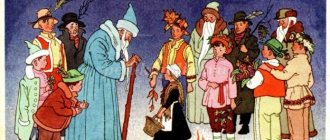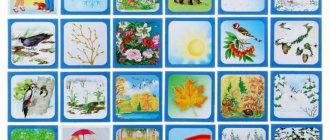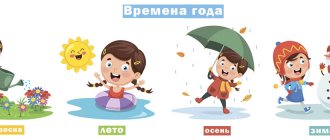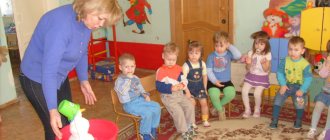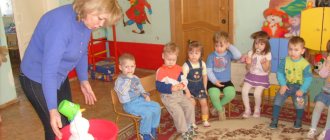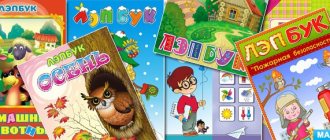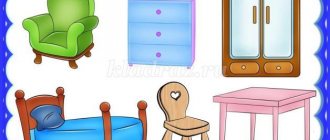Exploratory activities on a walk in different seasons
Experience 1:
make a cut with a shovel so that all layers of soil are visible.
♦ How many layers of soil does the ravine have? Which? (Below there are stones, then sand with clay and the top fertile layer of soil.)
Add water.
How does water penetrate soil layers? (The fertile layer of soil easily allows water to pass through; clay and sand do not, because there is no air in the clay.)
What vegetation predominates in the ravine? (Flowers and Curves.)
Experience 2:
consider the top fertile layer of soil.
♦ What is contained in this soil layer? (Rotten matter , their roots, animal remains.)
Guys, to prevent the ravines from getting bigger, people have found a way to strengthen the soil. To do this, you need to plant trees along the slope of the ravine. Their roots are long, penetrate far deep and help keep the soil from being washed away by rain streams. And the clay part of the soil is favorable for tree roots, as it retains moisture longer, and the tree can drink.
Examine through a magnifying glass the branch from which a leaf has just fallen.
♦What did we see? (Barely noticeable buds.)
What does it mean? (The trees did not die, they only shed dead, unnecessary leaves.)
The teacher invites the children to conduct an experiment.
Pour water into a glass jar, close the lid tightly and leave in the cold. Soon the can will split, and instead of it there will be a piece of ice. Frozen water - ice - takes up more space than liquid water, so the ice in the jar became crowded, and it broke it. Ice appears on puddles, rivers, and ponds as soon as the first frost hits. With each frosty day, the ice crust becomes thicker. What happens to ice if it is brought into a warm room? (It will melt.)
What kind of snow can you sculpt from? Try to make a ball of snow.
Compare the freezing time of clean and colored water in large and small molds.
Compare the rate of melting of snow packed tightly or loosely in a glass.
Examine the tracks of birds, compare them with the tracks of a crow. Answer, what is the difference between birds and animals?
Find clouds that look like horses. Compare cirrus and cumulus clouds.
Winter
Research activities
Measure the depth of snow with a snow gauge in different parts of the site.
Determine the condition of the soil in winter.
Catch a flying snowflake on a blank sheet of paper, examine it and determine the properties of snow (snowflake, dust, grain, flakes).
Examine the tracks of birds, compare them with the tracks of a crow. Answer, what is the difference between birds and animals?
Rays of light always travel in a straight line, and if
If any object comes across their path, it casts a dark shadow. Conduct observation - in the morning, at noon, in the evening. (At noon, the sun is directly overhead, the shadow is very short; early in the morning and in the evening the sun drops in the sky, the shadows become long.)
“Cognitive - research activities of preschoolers on walks”
Author information
Irgizzeva Olga Alekseevna –
Teacher of the preschool educational institution kindergarten “Kolosok”, Cherkasskoe village, Saratov region, Volsky district
2017
Cognitive and research activities of children on a walk
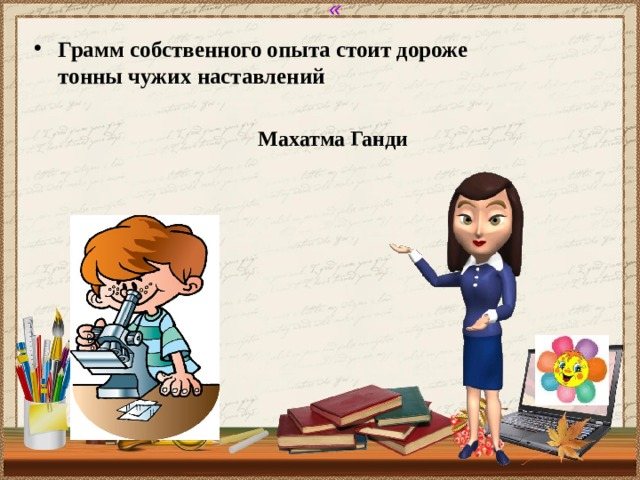
«
- A gram of your own experience is worth more than a ton of other people’s instructions.
Mahatma Gandhi
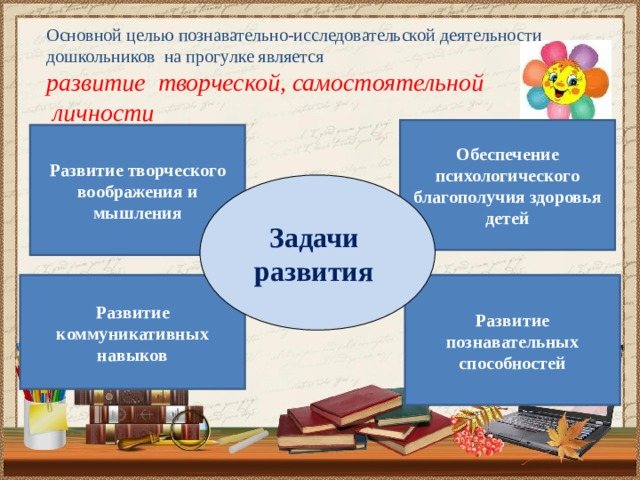
The main goal of educational and research activities
preschoolers on a walk is
development of creative, independent
personalities
Ensuring the psychological well-being of children's health
Development of creative imagination and thinking
Tasks
development
Development of communication skills
Development of cognitive abilities
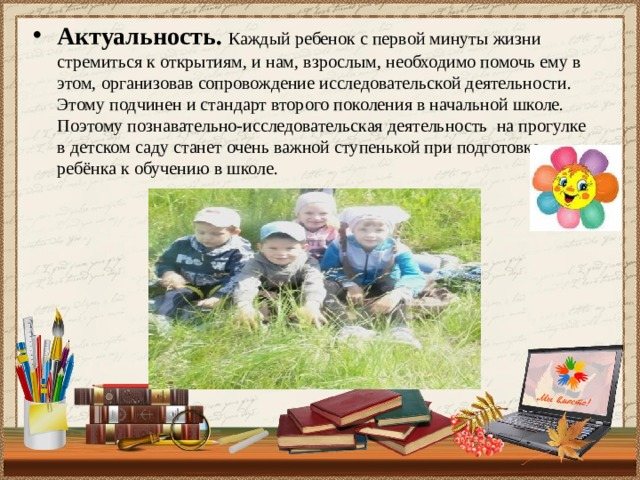
- Relevance.
Every child strives for discovery from the first minute of life, and we, adults, need to help him in this by organizing support for research activities. The standard of the second generation in elementary school is also subject to this. Therefore, cognitive and research activities during a walk in kindergarten will become a very important step in preparing a child for school.
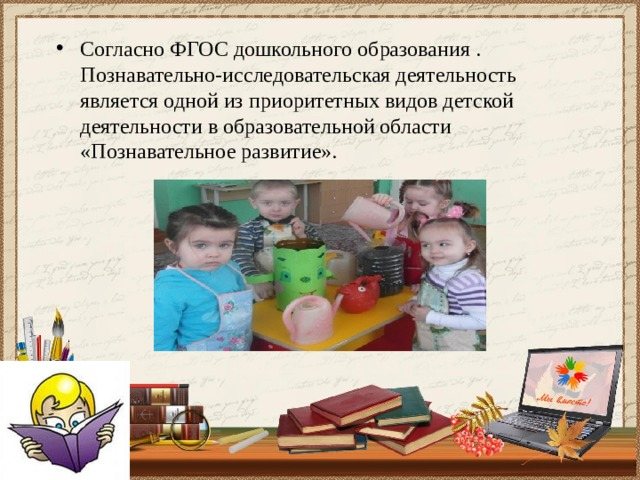
- According to the Federal State Educational Standard for Preschool Education. Cognitive and research activities are one of the priority types of children's activities in the educational field of “Cognitive Development”.
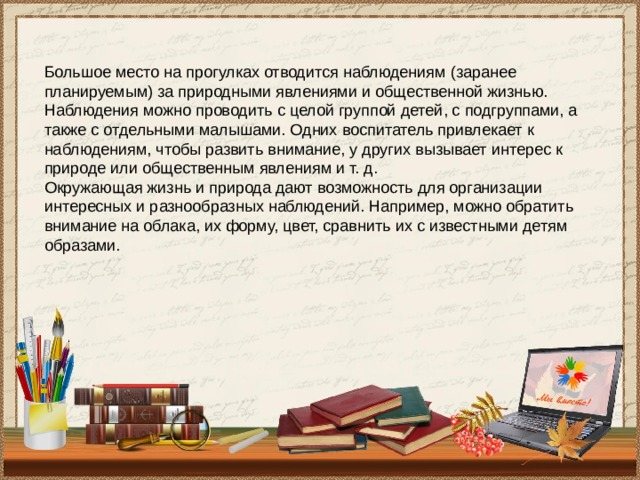
A large part of the walks is devoted to observations (pre-planned) of natural phenomena and social life. Observations can be carried out with a whole group of children, with subgroups, as well as with individual children. The teacher attracts some to observations in order to develop attention, while others arouse interest in nature or social phenomena, etc.
The surrounding life and nature provide an opportunity to organize interesting and varied observations. For example, you can pay attention to the clouds, their shape, color, and compare them with images known to children.
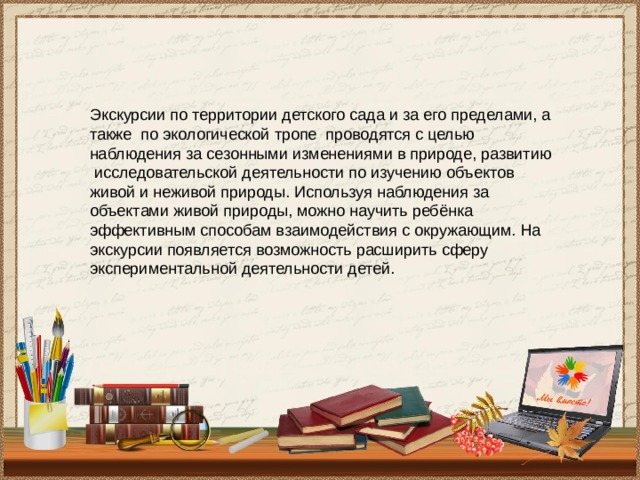
Excursions around the territory of the kindergarten and beyond, as well as along the ecological trail, are conducted with the aim of observing seasonal changes in nature, developing research activities to study objects of living and inanimate nature. Using observations of living nature objects, you can teach your child effective ways to interact with the environment. The excursion provides an opportunity to expand the scope of children’s experimental activities.
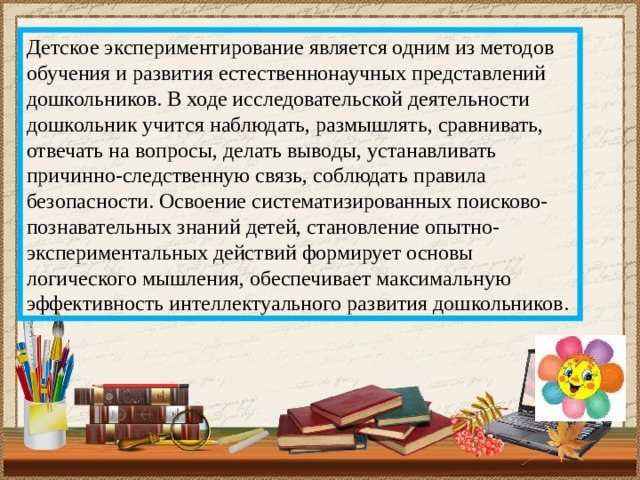
Children's experimentation is one of the methods of teaching and developing the natural science concepts of preschoolers. During research activities, a preschooler learns to observe, think, compare, answer questions, draw conclusions, establish a cause-and-effect relationship, and follow safety rules. The mastery of systematized search-cognitive knowledge of children, the formation of experimental actions forms the foundations of logical thinking, ensures maximum efficiency of the intellectual development of preschool children.
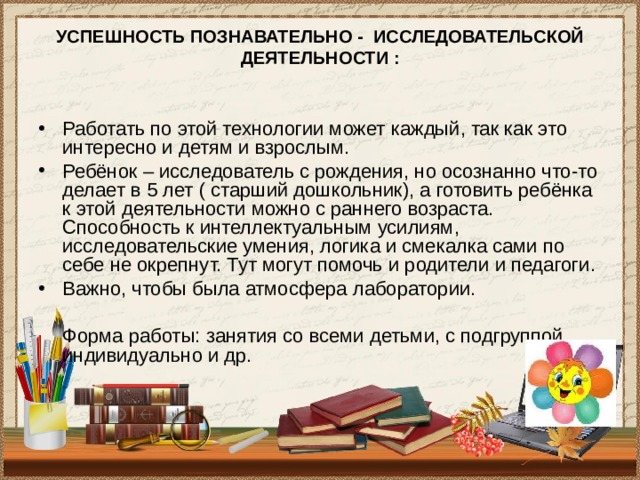
SUCCESS
OF COGNITIVE AND RESEARCH ACTIVITIES:
- Anyone can work with this technology, as it is interesting for both children and adults.
- A child is an explorer from birth, but consciously does something at the age of 5 (senior preschooler), and a child can be prepared for this activity from an early age. The ability for intellectual effort, research skills, logic and ingenuity will not become stronger on their own. Both parents and teachers can help here.
- It is important to have a laboratory atmosphere.
Form of work: classes with all children, with a subgroup, individually, etc.
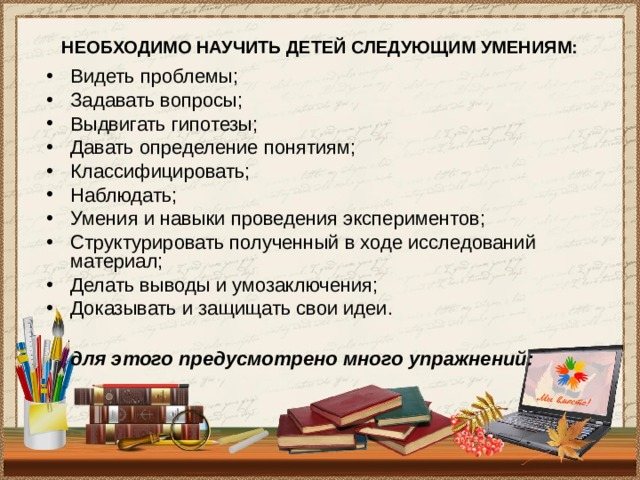
IT IS NECESSARY TO TEACH CHILDREN THE FOLLOWING SKILLS:
- See problems;
- To ask questions;
- Make hypotheses;
- Define concepts;
- Classify;
- Observe;
- Ability to conduct experiments;
- Structure the material obtained during research;
- Draw conclusions and conclusions;
- Prove and defend your ideas.
There are many exercises for this:
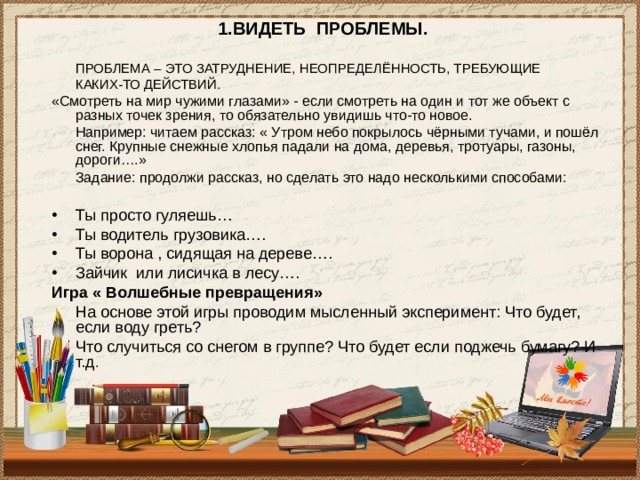
1. SEE PROBLEMS.
A PROBLEM IS A DIFFICULTY, UNCERTAINTY THAT REQUIRES
SOME ACTION.
“Look at the world through someone else’s eyes” - if you look at the same object from different points of view, you will definitely see something new.
For example: we read the story: “In the morning the sky was covered with black clouds and it began to snow. Large snow flakes fell on houses, trees, sidewalks, lawns, roads....”
Assignment: continue the story, but you need to do this in several ways:
- You're just walking...
- You are a truck driver...
- You are a crow sitting on a tree...
- A bunny or a fox in the forest...
Game "Magic Transformations"
Based on this game, we conduct a thought experiment: What happens if water is heated?
What happens to the snow in the group? What happens if you set fire to paper? Etc .
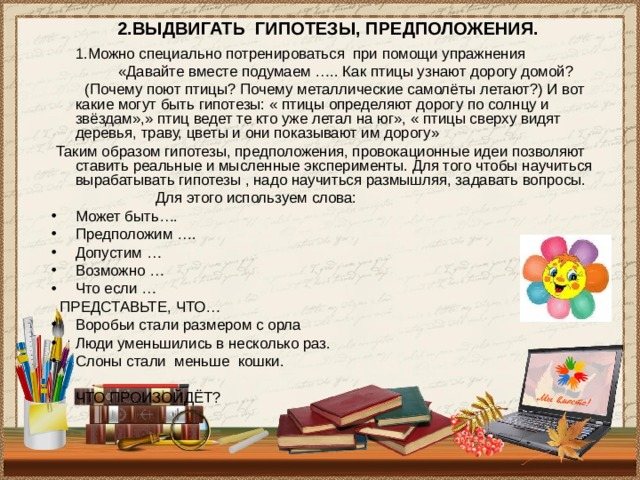
2. MAKE HYPOTHESES AND ASSUMPTIONS.
1.You can specifically train with the help of an exercise
“Let's think together... How do birds find out the way home?
(Why do birds sing? Why do metal planes fly?) And here are some hypotheses: “birds determine the road by the sun and stars”, “birds are led by those who have already flown south”, “birds from above see trees, grass, flowers and they show them the way"
Thus, hypotheses, assumptions, and provocative ideas allow us to set up real and thought experiments. In order to learn how to develop hypotheses, you need to learn to think and ask questions.
To do this we use the words:
- May be….
- Let's assume...
- Let's say...
- Maybe …
- What if …
IMAGINE THAT...
- The weapon became the size of an eagle
- People have shrunk several times.
- Elephants have become smaller than cats.
WHAT WILL HAPPEN?
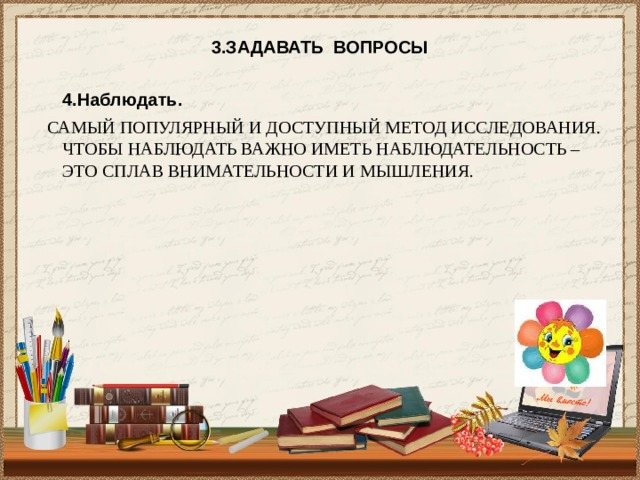
3.ASK QUESTIONS
4. Observe.
THE MOST POPULAR AND AVAILABLE RESEARCH METHOD. TO OBSERVE, IT IS IMPORTANT TO HAVE OBSERVATION – IT IS A ALLOY OF ATTENTION AND THINKING.
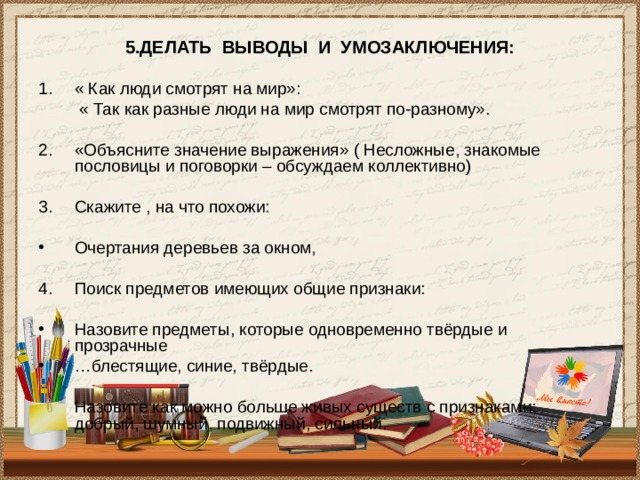
5.MAKING CONCLUSIONS AND CONCLUSIONS:
1. “How people look at the world”:
“Because different people look at the world differently.”
2. “Explain the meaning of the expression” (Simple, familiar proverbs and sayings - we discuss collectively)
3. Tell me what they look like:
- The outlines of the trees outside the window,
4. Search for objects that have common characteristics:
- Name objects that are both solid and transparent
- ... shiny, blue, hard.
Name as many living creatures as possible with the following characteristics: kind, noisy, active, strong.
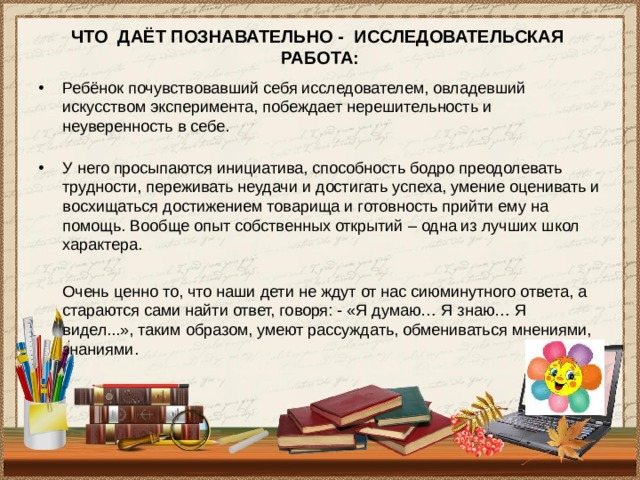
WHAT DOES
PROVIDE COGNITIVELY :
- A child who feels like a researcher, who has mastered the art of experimentation, overcomes indecision and self-doubt.
- He awakens to initiative, the ability to cheerfully overcome difficulties, experience failures and achieve success, the ability to evaluate and admire the achievement of a comrade, and the willingness to come to his aid. In general, the experience of one’s own discoveries is one of the best schools of character.
It is very valuable that our children do not expect a momentary answer from us, but try to find the answer themselves, saying: “I think... I know... I saw...”, thus, they are able to reason, exchange opinions and knowledge.
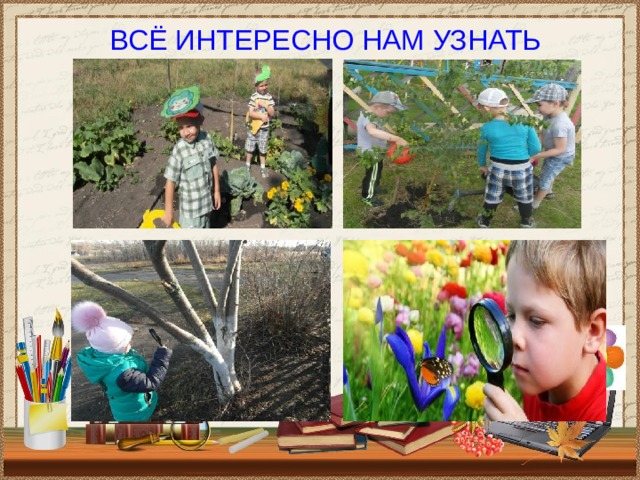
WE ARE INTERESTED TO KNOW EVERYTHING
Performance:
Improving the quality of mental activity.
Increased level of perception.
Increasing interest in the content of the activity
.
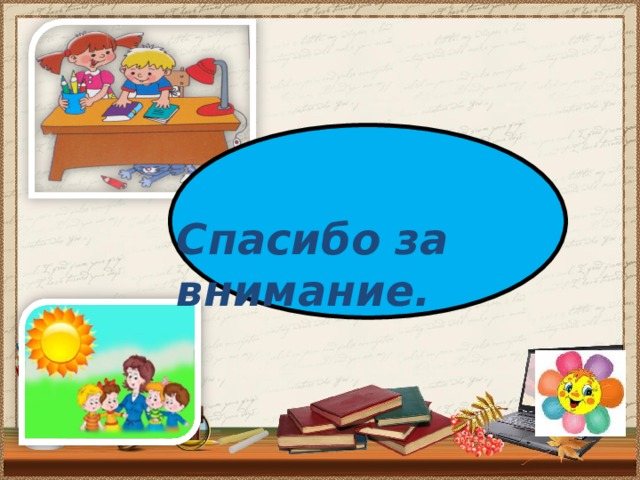
Thank you for your attention.
“What do we know about the snowball?” IOD in the middle group
Author - compiler:
Krylova Natalya Mikhailovna,
teacher
MADOU d/s No. 162 of the city of Tyumen
Summary of cognitive and research activities in the middle group
“What do we know about the snowball?”
as part of the project “Miracles for the New Year”
Goal: To stimulate children's curiosity, the desire to study natural phenomena (snow and its properties), to support children's interest in experimentation and research.
Program content:
- To form basic ideas about snow and its properties (snow melts in warmth, snow is not transparent, snow is white, snow has no smell).
- Teach children to draw conclusions through experimentation.
- Activate children's speech. Improve children’s ability to answer questions posed based on the content of the conversation.
- To develop thinking, interest in winter natural phenomena, the desire to actively learn and act.
Preliminary work
- Looking at paintings on a winter theme.
- Reading poems about winter and snowflakes.
- Observing falling snow, snowflakes, playing with snow on walks. 4. Drawing snowflakes.
Materials and equipment:
Demonstration - two containers for water, cold and warm water, toys Fixiki Nolik and Simka, TSO (laptop, TV, stereo system, flash drive with the musical game “Raking Snow with Your Hands...”, with the cartoon “What dangers can lurk in winter”, snowflake, cards depicting the main properties of snow.
Distribution - disposable plates for snow (for each child a deep and flat plate), snow, half a cut apple on two plates, a disposable spoon, plastic figures of a hedgehog and a fox, individual napkins.
GCD move
Educator: Guys, we have a lot of guests today, let’s say hello to them (the children say hello).
(The laptop is standing on the window, suddenly the sound “Oh-oh-oh” is heard from it (these are the screams of Nolik from the cartoon about Fixies))
Educator: Oh, what is that noise? Where is he from? (children with a teacher approach the laptop).
Children: These are probably Fixies.
Educator: Such miracles for the New Year!
Educator: Where are they, where did they hide?
(Children look for Fixies in the group room, go to the bedroom, see Fixies Nolik and Simka on the bed).
Educator: Who’s that under the blanket here? (It’s Fixies)
Educator: What are they doing? (They're warming up)
Educator: I understand. All night the laptop stood by the open window, and snow fell on the Fixies. So they froze and ran into the bedroom to warm themselves.
Educator: Guys, the Fixies told me that they came to visit us in order to find out what we know about snow. Shall we tell them? (we'll tell you).
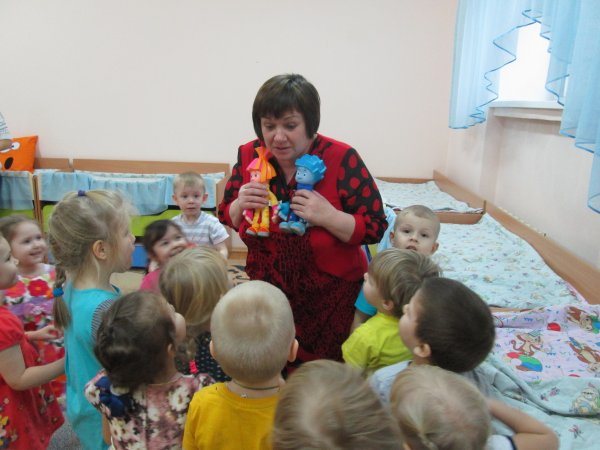
Educator: Well, then come in and sit on the carpet. And you, Fixies, make yourself comfortable and listen to us carefully. Together we will find out what kind of snow it is and what its properties are.
Educator: Guys, I brought snow to the group in the morning, but what happened to the snow now? (he melted)
Educator: Let's take and carefully examine the melted snow (places a container with melted snow in the middle).
Educator: What do you see? (we see water. The water has become dirty).
Educator: Guys, why is the water dirty? (There is a lot of dirt on the street, smoke from cars has settled on the snow. The snow is gray and dirty).
Educator: Guys, I saw that some children eat snow. Are they doing the right thing? (no, not correct)
Educator: Why can’t you eat snow? (snow is cold and dirty).
Educator: So, the snow melts, water is formed. To help us remember this, I will draw a picture of a drop of water on a card.
(a snowflake with the image of the first property is attached to the board: snow melts in warmth).
Educator: Oh, all the snow has melted, but how will we study it further? Where can we get it? (let's ask the junior teacher to bring us snow from the street)
Educator: Guys, come to the large common table, we will find out other properties of snow.
(The container with snow is placed in the middle of the table)
Educator: Let's touch the snow, what does it feel like? (cold).
Educator: Let's conduct an experiment. You have figures on your plates, name them (hedgehogs and chanterelles). What color are they? (gray, orange)
Educator: Put the fox in a flat plate, put a snowball on top, and put the hedgehog in a deep plate (the teacher pours water into a deep plate).
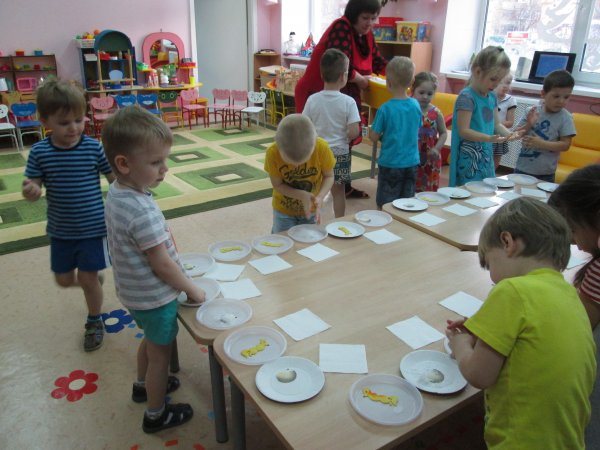
Educator: Which animal figurine is visible and which is not? (a hedgehog is visible, but a fox is not visible)
Educator: Why? (snow is not transparent, you can’t see anything through it, but the water is transparent)
Educator: So, the snow is not transparent. To help us remember this, I will draw and attach this card to the snowflake.
Educator: Guys, look at the plates and tell me what color is the water? (colorless) What about snow? (snow is white)
Educator: What else is white? (cotton wool, clouds in the sky, drawing paper...)
Educator: So, the snow is white. To help us remember this, I will draw cotton wool on a card and attach it to a snowflake.
Educator: Guys, how do you know if snow smells? (you have to smell it).
Educator: Smell the snow, and now smell the apple. Does it smell like snow? (snow has no smell)
Educator: So, snow doesn’t smell. To help us remember this, I will draw a nose on the card and cross it out.
Educator: Fixies, do you know that we have an interesting game that we love to play with the guys, and we want to teach you how to play it.
Musical game “ Raking snow with your hands...”
(children perform movements to the music in accordance with the words together with the teacher)
Educator : Well done! We have conducted so many experiments together, and now I want to show you another experience.
Educator : (at the demonstration table) Look: I have two jars. We pour cold water into one (the child is invited to check
water temperature - touches), (cold). In the second, pour warm water (touch the container and make sure it’s warm). I drop snow into these jars at the same time (drops snow in two spoons).
Educator : Where did the snow melt faster and where slower? (it melted faster in a jar of warm water).
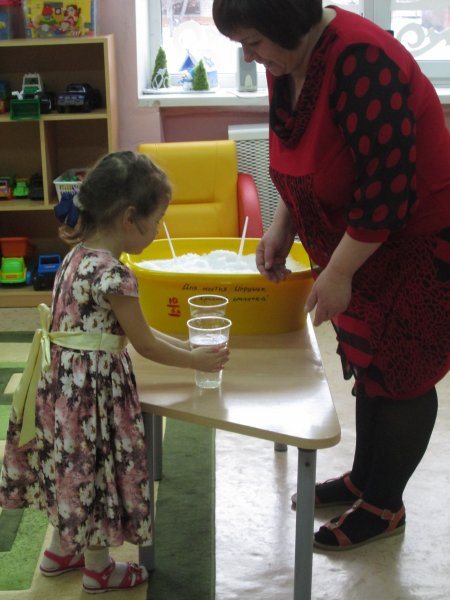
Educator : That's right, the warmer the water, the faster the snow melts, the speed of snow melting depends on the temperature of the water.
Educator: Guys, let's tell the Fixies about snow (children use reference drawings to talk about the properties of snow).
Educator: And now the Fixies invite you to watch a small cartoon in which they will introduce us all to the dangers that await us in winter.
List of used literature
1. Solomennikova O.A. Classes on the formation of elementary ecological concepts in the middle group of kindergarten. Lesson notes. – M.: Mosaic - Synthesis, 2007.- 48 p.
2. Novikovskaya O.A. Notes of complex classes with children 4-5 years old. Zip format file. ... Publisher: Parity ISBN 978-5-93437-248-5; 2008 208 pp.
3. Dybina O.V. Classes on familiarization with the outside world in the middle group of kindergarten. Lesson notes. – M.: MOSAIC – SYNTHESIS, 2010. – 80 p.
4. Reader for 4-5 years. V. Gerbova, N. Ilchuk and others - published by M. AST, 1997.
5. Nikolaeva S.N. Young ecologist. System of work in the middle group of kindergarten. For classes with children 4-5 years old. – M.: MOSAIC – SYNTHESIS, 2010. – 144 pp.: color. on
6.https://ru123.iplayer.info/song/109922136/Fizminutka_-My_igraem_v_snezhki./
“Certificate of publication in the media” Series A No. 0004913
We invite teachers of preschool education in the Tyumen region, Yamal-Nenets Autonomous Okrug and Khanty-Mansi Autonomous Okrug-Yugra to publish their teaching materials: - Pedagogical experience, original programs, teaching aids, presentations for classes, electronic games; — Personally developed notes and scenarios of educational activities, projects, master classes (including videos), forms of work with families and teachers.
Why is it profitable to publish with us?
1. “Kindergartens of the Tyumen Region” is an officially registered specialized media outlet at the federal level. 2. The activities of the editorial office are supported by the Department of Education and Science of the Tyumen Region 3. We issue a “Certificate of Publication” in the media. 4. The document has a unique number, is entered in the register, has the original seal of the editorial office of the online publication and signature. 5. “Certificate of publication” in the media is sent to the author in both paper and electronic versions.
Details >>>
Sample “Certificate of publication of author’s methodological material in the media.”pdf
Share
